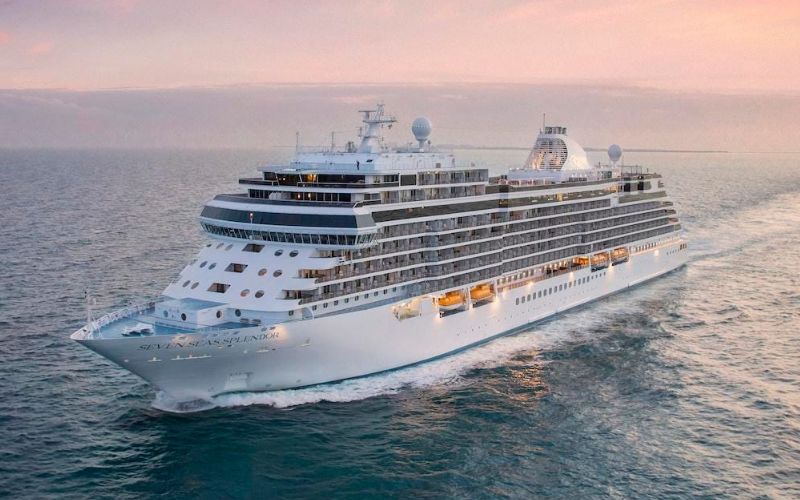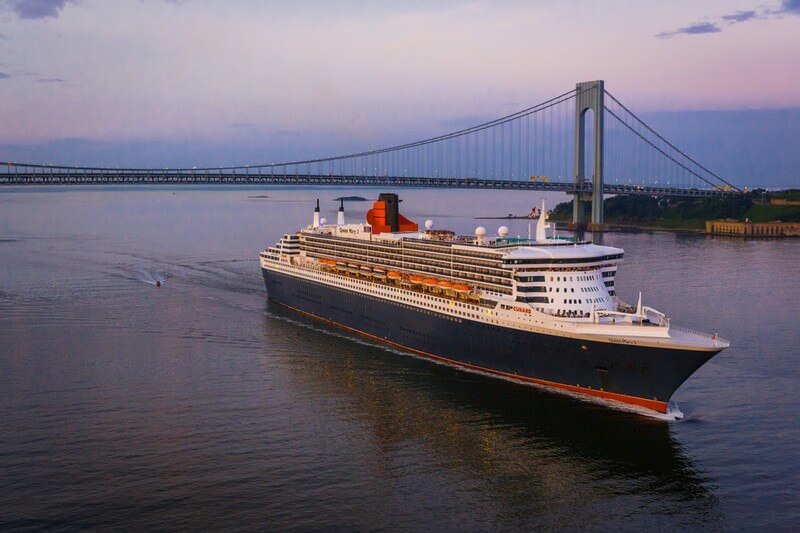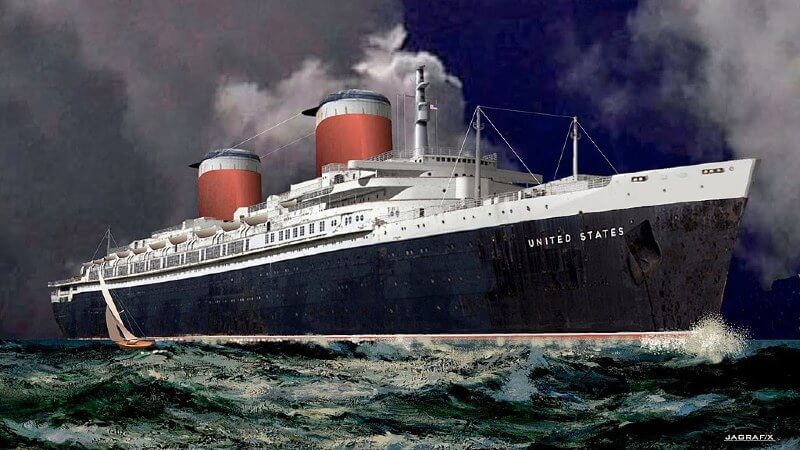Cruise ships are like huge floating cities, transporting up to 7,600 passengers around the world. Given their mammoth size, you may be wondering how fast cruise ships go…
Of course, how fast they ‘can’ go and how fast they choose to sail are two completely different measurements. Your car ‘can’ go a lot faster than you drive (I hope).

So it’s interesting to take a look at what’s possible, and the speeds they actually travel (and why).
Cruise Ships Average A Relatively Slow Speed
The average speed of a cruise ship is 18 to 22 knots (20 to 25 miles per hour). The maximum top speed of a cruise ship is around three knots faster than its real-life average cruising speed. The fastest cruise ship, Cunard’s Queen Mary 2, can reach top speeds of up to 30 knots.
But when asking how fast does a cruise ship go, that’ll depend on how far it needs to travel. The average cruise ship speed is exactly that – an average.
In reality, the ship will only travel as fast as it needs to in order to reach the next port by morning. It’s very rare for a cruise ship top speed to be used – in fact, for itineraries visiting ports close to each other, the average speed of cruise ship travel might be much lower.
Converting Knots to MPH
To convert a speed in knots to miles per hour, you can multiply the knots by 1.151.
Why We Use Knots Instead of Miles Per Hour
Knots means ‘nautical miles per hour’. A nautical mile is 6,076 feet, which is about 15% more than a mile on dry land (which is called a statute mile).

I once heard Captain Wesley Dunlop, who was the captain of P&O Cruises’ Britannia at the time (he’s since joined Disney Cruise Line), joke that a nautical mile was longer because the land is quite flat but the sea goes up and down! Of course, this isn’t the real reason for the difference between nautical miles and statute miles.
The measurement of miles on land dates back to Roman times and is based on 1,000 paces (only counting the left foot). Nautical miles were defined much later, in 1929, and are based on degrees of latitude around the earth.
The equator is a circle, which has 360 degrees. Each degree is divided into sixty nautical miles. This actually makes much more sense than statute miles, which are based on 1,000 times the length of two strides.
Read more: What Is A Knot In Terms of Speed And Why Is It Called That?
The Maximum Speed of a Cruise Ship
Cruise ships tend to have a top speed of around 25 knots, though it’ll vary by ship. The top speed of cruise ships is usually considered quite irrelevant, as cruise ships hardly ever reach their maximum speeds!
The only time a cruise ship tends to reach its top speed is during sea trials. These are test voyages in which a brand new cruise ship is taken out into the ocean and put through its paces to confirm that it meets specifications.
So, even if a cruise ship has a top speed of 25 knots, it will realistically only ever travel at about 20 knots because this speed is much more efficient.
Just like when you drive your car on the motorway, if you drive at 80 mph, you’ll burn much more fuel during the journey than you would if you stuck to a steady 60 mph. With something as large as a cruise ship, that extra fuel will be very expensive.
Suggested read: How Much Fuel Does A Cruise Ship Hold?
When a cruise ship goes faster, the ride also becomes bumpier for the passengers. The slower the ship is travelling, the more submerged the hull is, which makes for a smoother ride.
Cruise ships do sometimes go faster than the standard speed, such as when there is bad weather that they must quickly move away from. If another ship puts out a distress call, then a cruise ship may also speed up to offer assistance as soon as possible.
Top Speed is an Average
Cruise ships can go faster when they’re going in the same direction as the waves. However, rather than waiting for the right sea conditions to break speed records, cruise lines always use an average that factors in going both with and against the waves. This is a more accurate way to measure the top speed.
Newer Ships Are Quicker
Faster cruise ships don’t necessarily have more powerful engines. The difference in speed is due to efficiency.
Newer cruise ships have more advanced technology, like air bubble systems under the hull. These reduce friction between the ship and the water, meaning that they can go faster with the same fuel, or, as more commonly happens, go the same speed with less fuel.
The Fastest Cruise Ship
Deciding which is the fastest cruise ship depends on your definition of a cruise ship. Small passenger ships and ocean liners are the fastest, but these aren’t technically cruise ships. Smaller ships can go faster because they carry less weight, while ocean liners are designed to be more aerodynamic.

Photo credit: Cunard
Some people may consider Cunard’s Queen Mary 2 to be the fastest cruise ship with a top speed of 30 knots. However, you may be surprised to learn that she’s not technically a cruise ship, she’s an ocean liner! This ship is designed to transport passengers across the Atlantic, sitting lower in the water with a pointed bow and an extra-thick hull compared to a true cruise ship.
You can read more about the differences between cruise ships and ocean liners here.
There’s no official record of the fastest cruise ship as cruise ships rarely, if ever, use their top speed. However, several ships from Holland America Line, Norwegian Cruise Line and Royal Caribbean have been known to reach speeds of over 25 knots (29 mph) during sea trials.
The Fastest Ocean Liner On Record
The fastest ocean liner ever built was the SS United States which, on her maiden voyage in 1952, shattered the trans-Atlantic speed record and reached a top speed of 39 knots (45 mph). [Source].
Although the 1,928-passenger SS United States retired from service in 1969, she still holds the record as the fastest ocean liner to cross the Atlantic in either direction.

Photo credit: JAGRAFXWIK, CC BY-SA 4.0,
In the 1950s, the time it would take to complete an ocean crossing was a major selling point for cruise lines. These days, however, people prefer to cruise at a more leisurely pace and call at several destinations during the voyage.
The Average Speed of a Cruise Ship
The speed at which cruise ships travel on open seas is known as ‘cruising speed’ or ‘service speed’. This speed offers the best combination of distance travelled and fuel economy.
The actual speed at which a cruise ship travels may be influenced by:
- Itinerary: Cruise ships travel slower when they have plenty of time to reach the next port of call
- Fuel: Faster speeds are less fuel-efficient so a ship will slow down if it needs to conserve fuel
- Distance to shore: Cruise ships slow down as they approach ports. If they arrive early they may even stop and anchor at sea
- Hazards: In some areas, such as Alaska, cruise ships proceed with extra caution to avoid glaciers
- Weather: Cruise ships may speed up to move out of the path of storms. If the weather is rough, they may also slow down, preferring to make up progress over flat seas
Have you noticed how time of day isn’t listed there?
Cruise ships don’t travel any faster or slower in the night. While visibility is obviously reduced in the dark, cruise ships have equipment that means that they can look out for hazards, even in the dark. Plus, other vessels have lights, so they’re easy to spot.
The Maximum Distance a Cruise Ship Can Travel in a Day
In 24 hours, a cruise ship travelling at the standard service speed can cover about 480 nautical miles (which equates to 552 land miles).
- From the UK: A cruise ship departing from Southampton on the south coast of England, could reach as far as Newcastle Upon Tyne in the North East of England in 24 hours.
- From Florida: A cruise ship departing from Port Canaveral, Florida, could reach as far as Havana, Cuba in 24 hours
- From Spain: A cruise ship departing from Barcelona, Spain, could reach as far as Livorno (Pisa), Italy in 24 hours
Of course, these are hypothetical journeys. Cruise ships time their journeys to dock at ports in the early morning and depart in the evening to allow passengers to explore. If the distance between two ports is too great, the ship will spend a day at sea.
The Bottom Line
Cruise ships travel relatively slowly, with an average speed of 18 to 22 knots (20 to 25 miles per hour). Ocean liners like Queen Mary 2 can reach top speeds of 30 knots, but for true cruise ships, the maximum speed is more like 25 knots.
So when asking how fast can a cruise ship go, really you’re asking about theoreticals – because ships will only travel as fast as they need to.
Related Posts:
- How Much Does a Cruise Cost?
- How Big Is A Cruise Ship?
- Where Are The Engines On A Cruise Ship?
- How Do Cruise Ships Float?

Jenni Fielding is the founder of Cruise Mummy. She has worked in the cruise industry since 2015 and has taken over 30 cruises. Now, she helps over 1 million people per month to plan their perfect cruise holidays.


